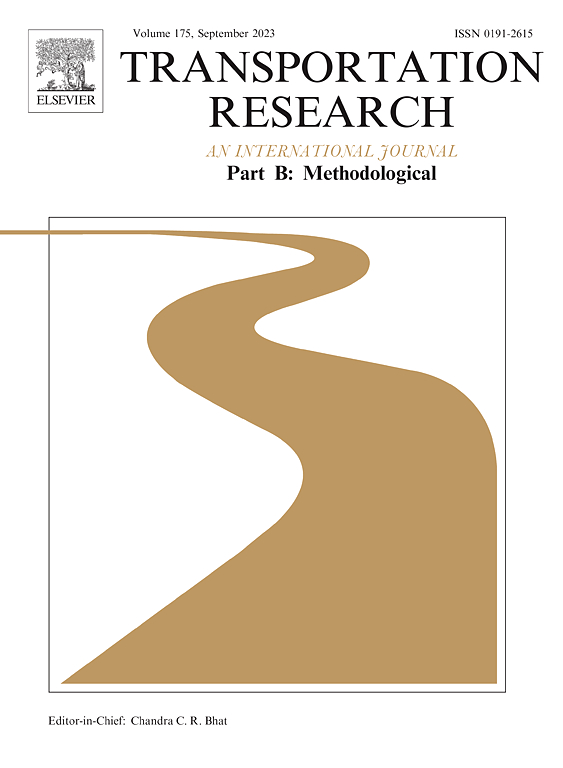A novel hierarchical perimeter control method for road networks considering boundary congestion in a mixed CAV and HV traffic environment
IF 6.3
1区 工程技术
Q1 ECONOMICS
引用次数: 0
Abstract
Under dynamic traffic demand conditions, two issues must be addressed when perimeter control is implemented for congested areas of a road network. The first is to avoid intersection spillback at the boundaries and expansion of the congestion, and the second is to improve the output traffic efficiency of the congested areas to quickly relieve traffic congestion. To address these two issues and solve the traffic congestion problem, in this paper, we adopt a dynamic buffer area to store boundary queuing vehicles and use connected and autonomous vehicle (CAV) technology to improve the traffic flow transmission efficiency of a congested area. First, considering the macro- and micro-level relationships between the macroscopic fundamental diagram (MFD) regions and buffer areas (link- and node-based), a traffic flow transmission model of the network embedded in dynamic buffer areas is built. Second, based on road network state sensing, a dynamic adjustment method of buffer volume is presented to optimize MFD region boundary flows. Third, a hierarchical control method based on model prediction (HCMMP) is proposed for the scenario of a single kernel network. The HCMMP's upper level adopts model predictive control (MPC) to adjust the traffic flow into the dynamic buffer area, and the lower level uses real-time CAV information to optimize the signal timing in the dynamic buffer area. Finally, a complex cellular multiregional road network is selected as a scenario case, and the proposed HCMMP is analysed and compared with no control (NC), proportional integral (PI) control, MPC (both without a dynamic buffer area), PI control with a dynamic buffer area (PIBA) and hierarchical control method based on the PI (HCMPI). The results show that the proposed HCMMP can improve the traffic efficiency, outperforming the other control methods.
一种考虑CAV和HV混合交通环境中边界拥塞的路网分层周长控制方法
在动态交通需求条件下,对路网拥堵区域实施周边控制必须解决两个问题。一是避免边界交叉口溢出,扩大拥堵范围;二是提高拥堵区域的输出交通效率,快速缓解交通拥堵。针对这两个问题,为解决交通拥堵问题,本文采用动态缓冲区存储边界排队车辆,并利用互联与自动驾驶汽车(CAV)技术提高拥堵区域的交通流传输效率。首先,考虑宏观基本图(MFD)区域和缓冲区(基于链路和节点)之间的宏观和微观关系,建立了嵌入动态缓冲区的网络交通流传输模型。其次,基于路网状态感知,提出了缓冲区容积的动态调整方法,以优化 MFD 区域边界流量。第三,针对单一内核网络的情况,提出了基于模型预测的分层控制方法(HCMMP)。HCMMP 的上层采用模型预测控制(MPC)来调整进入动态缓冲区的交通流,下层利用实时 CAV 信息来优化动态缓冲区的信号配时。最后,选择了一个复杂的蜂窝式多区域道路网络作为情景案例,分析并比较了所提出的 HCMMP 与无控制(NC)、比例积分(PI)控制、MPC(均无动态缓冲区)、带动态缓冲区的 PI 控制(PIBA)和基于 PI 的分层控制方法(HCMPI)。结果表明,所提出的 HCMMP 可以提高交通效率,优于其他控制方法。
本文章由计算机程序翻译,如有差异,请以英文原文为准。
求助全文
约1分钟内获得全文
求助全文
来源期刊
CiteScore
12.40
自引率
8.80%
发文量
143
审稿时长
14.1 weeks
期刊介绍:
Transportation Research: Part B publishes papers on all methodological aspects of the subject, particularly those that require mathematical analysis. The general theme of the journal is the development and solution of problems that are adequately motivated to deal with important aspects of the design and/or analysis of transportation systems. Areas covered include: traffic flow; design and analysis of transportation networks; control and scheduling; optimization; queuing theory; logistics; supply chains; development and application of statistical, econometric and mathematical models to address transportation problems; cost models; pricing and/or investment; traveler or shipper behavior; cost-benefit methodologies.

 求助内容:
求助内容: 应助结果提醒方式:
应助结果提醒方式:


